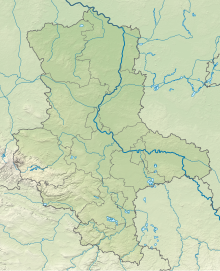Breakthrough in the Saale near Rothenburg
Coordinates: 51 ° 37 ′ 8.4 ″ N , 11 ° 45 ′ 7.2 ″ E
The Saale breakthrough in Rothenburg is a nature reserve in the small town Gerbstedt in Mansfeld-Südharz and the city of Wettin-Löbejün in Saalekreis in Saxony-Anhalt .
The nature reserve, which consists of several sub-areas and is designated NSG 0199, is around 221 hectares in size. A large part of it is part of the FFH area of the same name . A part of the area north of Rothenburg borders the nature reserve " Teufelsgrund und Saalehänge " in the north . A part of the area to the northwest of Dobis borders the nature reserve " Saalehänge bei Dobis " in the east . The reserve is adjacent to a large extent to the conservation area "Saale". The area has been under protection since 2000 (date of regulation: October 11, 2000). Responsible lower nature conservation authorities are the district of Mansfeld-Südharz and the Saalekreis.
The nature reserve, which combines several areas of natural monuments to form a nature reserve, extends in the Lower Saale Valley nature park southwest of Könnern on both sides of the Saale between the Rothenburg district of Wettin-Löbejün and the Friedeburg (Saale) district of Gerbstedt. It includes various habitats in the area of the opening of the Saale by the Hall-Hettstedter Mountain Bridge with the Saaleaue on the right bank of the river, a plurality of valleys in Dobis and Rothenburg, Castle Hill Rothenburg and slopes of Saalberg and Eichberg at Friedeburg (Saale).
The Saale floodplain is mainly used as grassland . In the surfaces of trees and riparian forest residues accompanied bayous and wetlands with reeds embedded. The floodplain is a habitat for brown hares as well as various bat species , including pug bat and great mouse- eared bat . The oxbow lakes with their reed stocks are u. a. Habitat of bitterling and various amphibian species . From a botanical point of view, stocks of the common marshmallow are worth mentioning.
The grassland areas are of particular importance as resting and feeding areas for numerous species of birds , including various snipe birds , ducks , divers and seagulls . They also serve as feeding habitats for various birds living in the area, including birds of prey , barn owls , crows and gray herons .
On the slopes , which in some cases steeply descend towards the Saale valley , various forest communities grow , including sessile oak-hornbeam-slope forests and field elm-slope forests as well as in humid locations rich hardwood, common oak-hornbeam forests with transitions to wet forests. Further, fields of rock and semi-dry grassland with Transylvanian melic , Haarpfriemengras , Steppe fennel , Nodding and Common Kuhschelle , Sichelblättrigem Hasenohr , Exceptional Frans gentian , Rispenflockenblume , Kleiner meadow rue , colorful flags vetch, Stem Losem tragacanth , Berggamander , Gray Skabiose , shaggy flags Wicke and plant associations of the spring grass Steppe Lawn, Valais Fescue lawns, eyelash pearl grass meadows, blue fescue and meadowsweet lawns to be found. In the hillside areas, valuable dry bushes with softwood , cotoneaster, several types of rose and hawthorn , blood-red dogwood and privet grow. The diversity of biotopes is complemented by orchards and abandoned quarries .
The dry slopes offer suitable habitats for numerous bird species, including red kite , black kite , goshawk , honey buzzard , long-eared owl , partridge , common raven , stock dove , black woodpecker , reversible neck , red- backed killer , wheatear , sparrowhawk and gray bunting . Furthermore, there are several breeding pairs of the bee-eater that breed in a loess wall near Friedeburg and the hoopoe can also be found occasionally. A special feature is the breeding of the House Martin is on rocks.
Furthermore, numerous invertebrates can be found in the nature reserve , including occurrences of endangered ground beetles , butterflies , grasshoppers and wild bees .
To connect the dry warm locations are partially arable land and intensively used grassland and former open habitats, mainly in the 1950s with locust trees were planted, included in the nature reserve. The Robinia plantations are to be converted into semi-natural mixed deciduous forests in the medium term . In order to counteract the encroachment of the semi- arid lawns that were previously grazed by sheep, decoupling measures or the resumption of grazing are necessary. Some areas have been grazed with goats since 2007, and their browsing causes shrubs to be pushed back.
Web links
- Saale breakthrough near Rothenburg , Saxony-Anhalt State Administration Office
- Hikes in the "Lower Saale Valley" nature park - the breakthrough valley of the Saale near Rothenburg , leaflet from the "Lower Saale valley" association. V. (PDF, 2.3 MB)
Individual evidence
- ↑ Conservation and sustainable development of FFH habitat types in FFH area 114 - Saale breakthrough near Rothenburg , Landschaftspflegeverein Saaletal e. V. Retrieved May 16, 2019.




